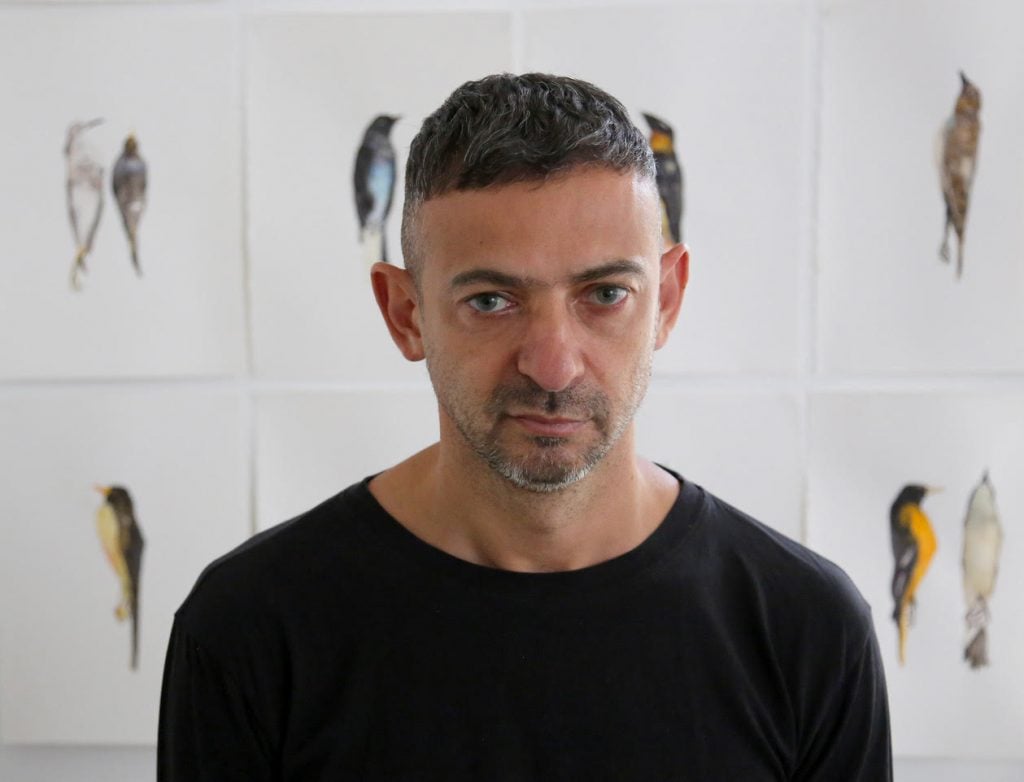Violence, and its archaeological, social and environmental impact on the earth, has long been a principal theme in the Lebanese artist Ali Cherri’s diverse body of work. Based between Paris and Beirut, Cherri has worked on projects that have led him to explore a 5,000-year-old necropolis in Sharjah’s desert, and reconstruct a Syrian astronaut’s historic journey to space in 1987. Regardless of the subject, a constant theme in Cherri’s practice is how to bring about social change in the present by revisiting sites of present and past destruction through our imagination.
In Cecilia Alemani’s The Milk of Dreams, the main exhibition of the 59th Venice Biennale, where he won the Silver Lion Award for Promising Young Participant, Cherri is currently showing Titans (2022), three enigmatic and otherworldly sculptures, and the three-channel video installation Of Men and Gods and Mud (2022). He considers the works part of a larger project that include two short films, The Disquiet (2013) and The Digger (2015), and his first feature film, The Dam (2022), which premiered at the Cannes Film Festival last month.
“These works look at geographies of violence, and how violence is dissolved within the landscape,” Cherri told Artnet News, “and how through an observation of material manifestation of the elements we can retrace histories of violence and socio-economic and political power structures that govern us and then influence the landscape.”
In The Disquiet, which Cherri shot in Beirut, he looked at the history of his home country. “It was about earthquakes and the idea of living in this ongoing catastrophe and there the element was earth,” Cherri explains. The film examined the fact that while current events in Lebanon focus on the political and social structures that have long split the nation, the actual ground on which the country stands is cracking, since it is located on several major fault lines in the earth’s crust.
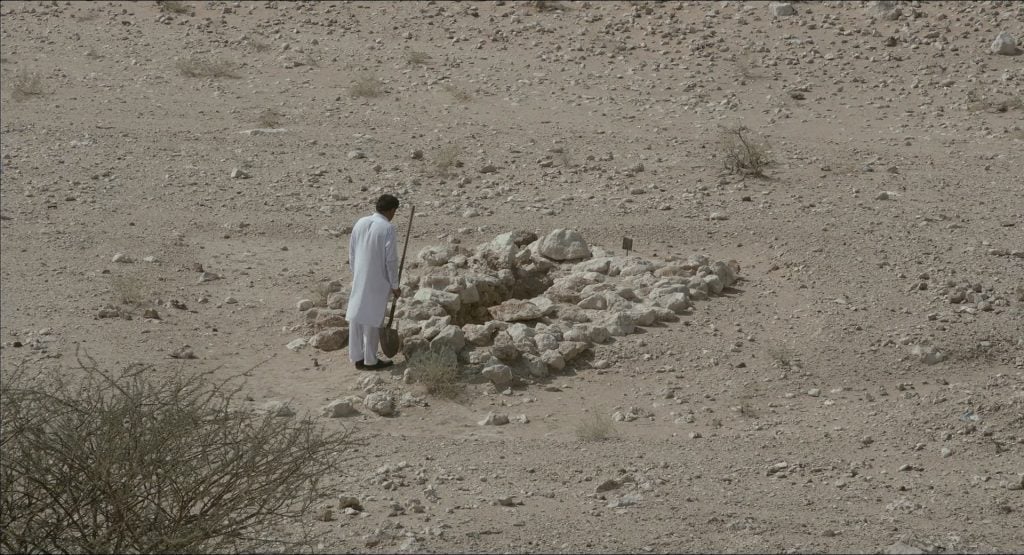
A still from Ali Cherri’s film, The Digger (2015). Photo: © Ali Cherri.
The Digger, which was shot in the desert between Sharjah and Abu Dhabi, continued this underground excavation by following the daily routine of a caretaker of a 5,000-year-old necropolis. The film looked “at the production of post-historical narrative—this whole idea of digging up the dead in order to write history,” Cherri says.
Metaphorically, the idea of digging into the earth to tell a new story about what took place there in the past forms the essence of Cherri’s work. It is about giving death a new meaning, and the people, plants, and animals who perished as part of the world’s perpetual tale of destruction, a chance to live on.
“The question is: how do we deal with the traces of the dead?” Cherri says. “How do we make these objects say something or be part of our discourse, and how do certain objects also resist certain discourses?”
For years, Cherri’s institutional work has revolved around the display of objects and fragments that have been dug up or destroyed. What is crucial for Cherri is to look at the materiality of an object and what happens when it is placed within a new context.
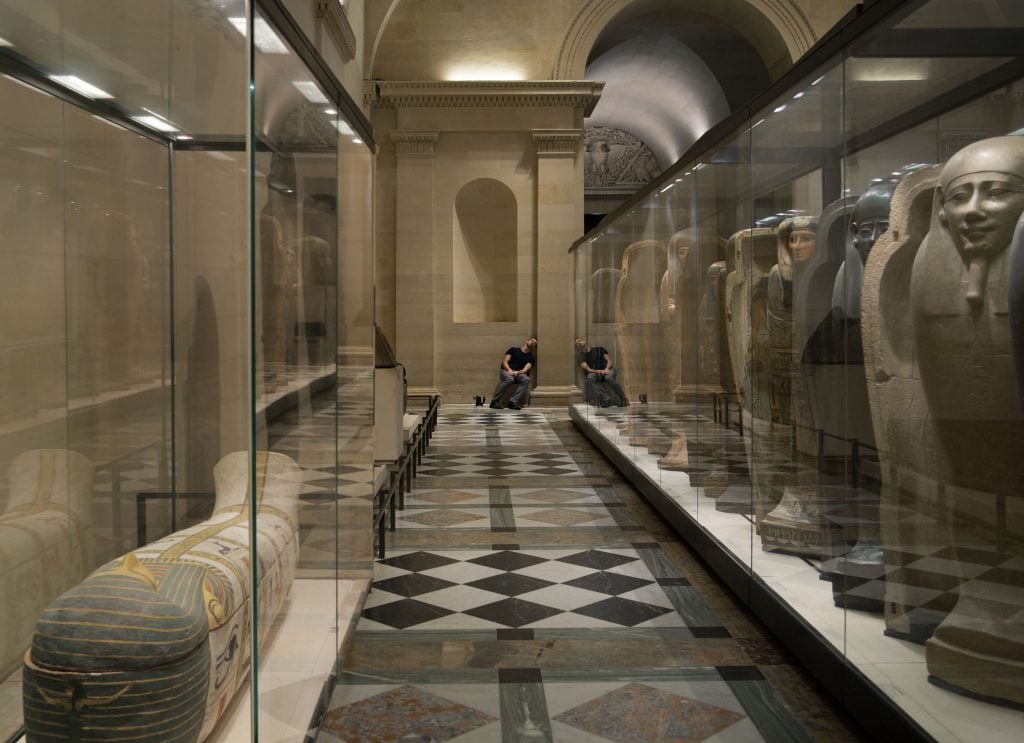
A still from Ali Cherri’s film, Somniculus (2017). Photo: © Ali Cherri.
In March, for example, as part of his residency at the National Gallery in London, Cherri presented the exhibition “If you prick us, do we not bleed?”, in which he uncovered accounts in the museum archives of paintings being vandalized while on display. His resulting works attempted to explore how trauma can manifest itself in people’s responses to gallery collections.
Titans, his sculptural works in Venice, seem to pendulate between the ancient and the contemporary. Made in a mixture of terracotta, wood and metal, the animal and human hybrid figures have an almost inviting quality to them, as if they were guardians of another time and place, welcoming those who behold them into another realm. Modeled after mythological figures such as the Assyrian lamassu, an ancient protective deity, the sculptures harken back to some of the earliest works of art, when figures were created using a simple combination of water and earth.
“When it comes to mud, as seen in Titans, the project was really about this coming together of earth and water, and how this mixture throughout history has been almost the mixture of the imagination. Throughout humanity, all over the world, in different cultures and in different times, people saw in this mixture the creation [of humanity],” Cherri explains. “Adam is created from mud [in the Biblical Book of Genesis] as is Enkidu from the Epic of Gilgamesh.”
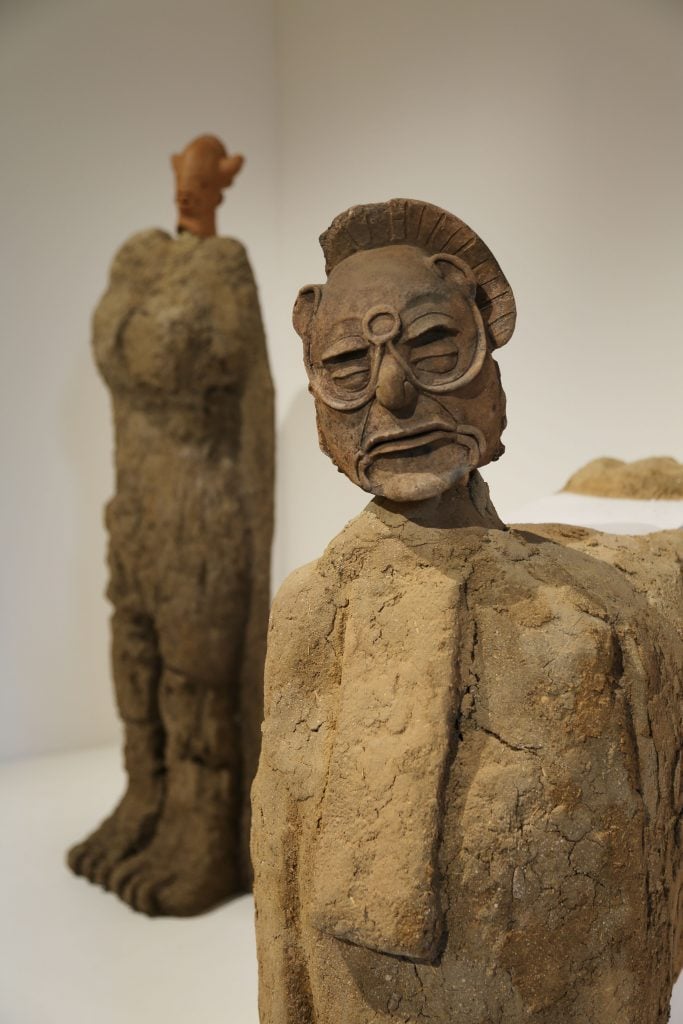
Ali Cherri, Titans (2022, detail). Photo: © Ali Cherri.
Earth is also a central character in Cherri’s multichannel video installation Of Men and Gods and Mud (2022), now on view in the Arsenale in Venice. It charts the history of the Merowe Dam in northern Sudan, one of the largest hydroelectric dams in Africa and a highly controversial construction on the Nile that has led to rampant social unrest. Its building in the early 2000s led to the displacement of more than 50,000 people and the forced relocation of families from their riverside lands into the inhospitable Nubian desert.
“Merowe Dam was a political project made by former Sudanese president Omar al-Bashir. For me, it is a metaphor for a repressive political regime that builds this massive structure that then destroys people’s lives,” Cherri says.
But the Merowe Dam is only one of several dams on the Nile, including Aswan and the Grand Ethiopian Renaissance Dam (GERD). The latter, which is being built in northern Ethiopia with Chinese government investment, has sparked tensions between Sudan, Ethiopia, and Egypt over control of water supplies, bringing the nations close to war.
“In 2017, when I first visited the Merowe Dam, one of the most destructive dams in the world, it was the start of tensions between Egypt and Ethiopia on access to water,” he says. “I was interested in the history and evolution of water, and also the socio-political implications regarding the access to water—the power politics of water.”
Cherri notes how it is often said that the wars of the 21st century will be over water, and through his work he seeks a response from viewers on what they would do if faced with similar environmental catastrophes.
These themes—the environment, natural elements and how the living and the dead can rewrite history—all come together in Cherri’s first feature film, The Dam.
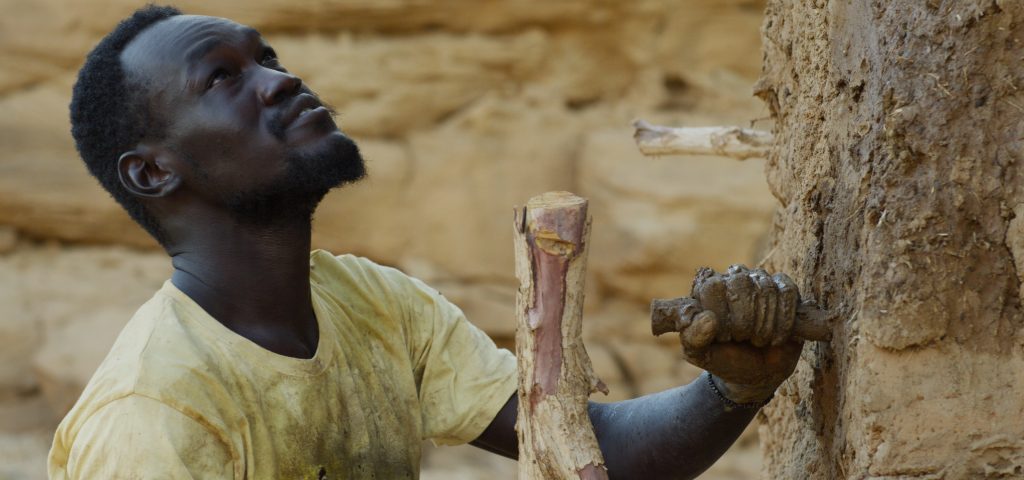
A still from Ali Cherri’s first feature film, The Dam (2022). Photo: © Ali Cherri.
The 84-minute-long film takes place once again in Sudan, near the Merowe Dam. The main character, a man named Maher, works in a traditional brickyard fed by the waters of the Nile. Every evening, he secretly wanders off into the desert to build a mysterious construction out of mud. While the Sudanese people rise to claim their freedom, his creation slowly starts to take on a life of its own.
“The Dam focuses on the power of the imagination as a political tool for change,” Cherri says, noting that authoritarian regimes, like Al-Bashir’s, hold onto power by colonizing the public’s imagination, so that people often do not know how to live without them. “In order to be able to change the reality in which you live, you need to be able to imagine a different world. Imagination in The Dam becomes a socio-emancipation from an economic and a political reality of oppression and exploitation,” he says.
“My work is about how our imagination can take us beyond our conditions,” Cherri adds. “Artists can thus create the conditions for these new worlds to evolve.”
